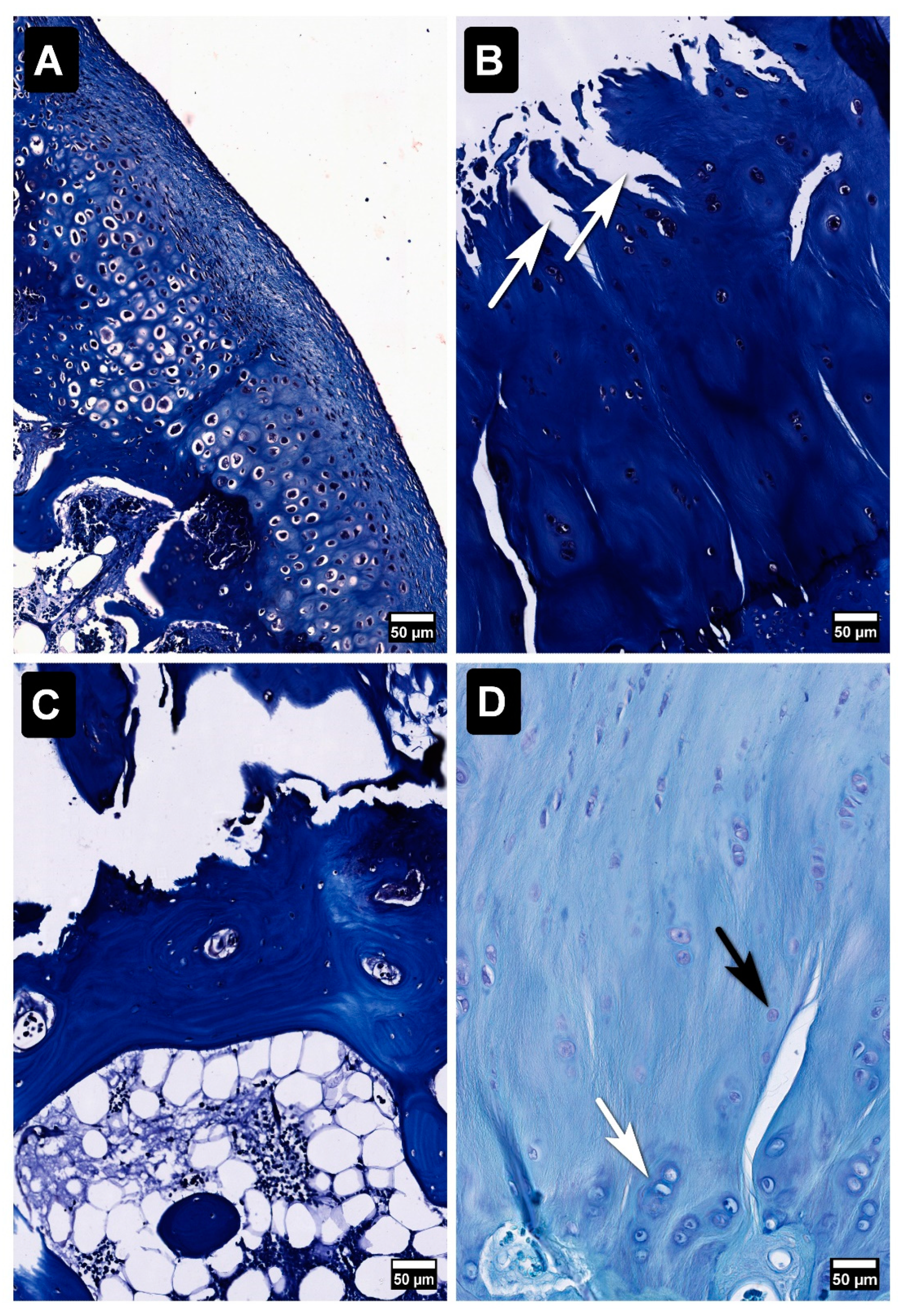Integrating Articular Cartilage Histopathology with CTX-II and COMP as Synovial Fluid Biomarkers for a Comprehensive Analysis in Osteoarthritis Evaluation †
1. Introduction
2. Methods
3. Results
4. Conclusions
Author Contributions
Funding
Institutional Review Board Statement
Informed Consent Statement
Data Availability Statement
Conflicts of Interest
References
- Liu, C.; Gao, G.; Qin, X.; Deng, C.; Shen, X. Correlation Analysis of C-terminal Telopeptide of Collagen Type II and Interleukin-1β for Early Diagnosis of Knee Osteoarthritis. Orthop. Surg. 2020, 12, 286–294. [Google Scholar] [CrossRef] [PubMed]
- Angelini, F.; Widera, P.; Mobasheri, A.; Blair, J.; Struglics, A.; Uebelhoer, M.; Henrotin, Y.; Marijnissen, A.C.; Kloppenburg, M.; Blanco, F.J.; et al. Osteoarthritis Endotype Discovery via Clustering of Biochemical Marker Data. Ann. Rheum. Dis. 2022, 81, 666–675. [Google Scholar] [CrossRef] [PubMed]
- Bai, B.; Li, Y. Combined Detection of Serum CTX-II and COMP Concentrations in Osteoarthritis Model Rabbits: An Effective Technique for Early Diagnosis and Estimation of Disease Severity. J. Orthop. Surg. Res. 2016, 11, 149. [Google Scholar] [CrossRef] [PubMed]
- Liem, Y.; Judge, A.; Kirwan, J.; Ourradi, K.; Li, Y.; Sharif, M. Multivariable Logistic and Linear Regression Models for Identification of Clinically Useful Biomarkers for Osteoarthritis. Sci. Rep. 2020, 10, 11328. [Google Scholar] [CrossRef] [PubMed]
- Pritzker, K.P.H.; Gay, S.; Jimenez, S.A.; Ostergaard, K.; Pelletier, J.-P.; Revell, P.A.; Salter, D.; Van Den Berg, W.B. Osteoarthritis Cartilage Histopathology: Grading and Staging. Osteoarthr. Cartil. 2006, 14, 13–29. [Google Scholar] [CrossRef] [PubMed]

Disclaimer/Publisher’s Note: The statements, opinions and data contained in all publications are solely those of the individual author(s) and contributor(s) and not of MDPI and/or the editor(s). MDPI and/or the editor(s) disclaim responsibility for any injury to people or property resulting from any ideas, methods, instructions or products referred to in the content. |
© 2024 by the authors. Licensee MDPI, Basel, Switzerland. This article is an open access article distributed under the terms and conditions of the Creative Commons Attribution (CC BY) license (https://creativecommons.org/licenses/by/4.0/).
Share and Cite
Semenistaja, S.; Sokolovska, L.; Studers, P.; Kadiša, A.; Groma, V.; Skuja, S. Integrating Articular Cartilage Histopathology with CTX-II and COMP as Synovial Fluid Biomarkers for a Comprehensive Analysis in Osteoarthritis Evaluation. Proceedings 2024, 103, 38. https://doi.org/10.3390/proceedings2024103038
Semenistaja S, Sokolovska L, Studers P, Kadiša A, Groma V, Skuja S. Integrating Articular Cartilage Histopathology with CTX-II and COMP as Synovial Fluid Biomarkers for a Comprehensive Analysis in Osteoarthritis Evaluation. Proceedings. 2024; 103(1):38. https://doi.org/10.3390/proceedings2024103038
Chicago/Turabian StyleSemenistaja, Sofija, Lība Sokolovska, Pēteris Studers, Anda Kadiša, Valērija Groma, and Sandra Skuja. 2024. "Integrating Articular Cartilage Histopathology with CTX-II and COMP as Synovial Fluid Biomarkers for a Comprehensive Analysis in Osteoarthritis Evaluation" Proceedings 103, no. 1: 38. https://doi.org/10.3390/proceedings2024103038
APA StyleSemenistaja, S., Sokolovska, L., Studers, P., Kadiša, A., Groma, V., & Skuja, S. (2024). Integrating Articular Cartilage Histopathology with CTX-II and COMP as Synovial Fluid Biomarkers for a Comprehensive Analysis in Osteoarthritis Evaluation. Proceedings, 103(1), 38. https://doi.org/10.3390/proceedings2024103038





